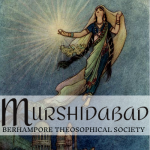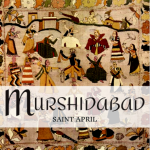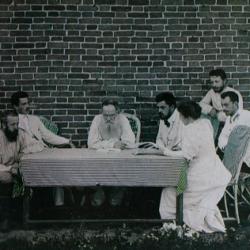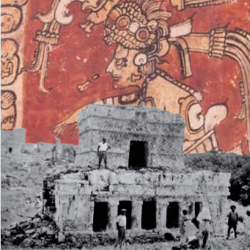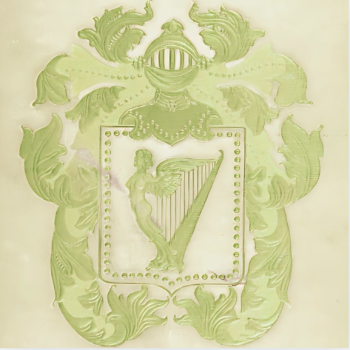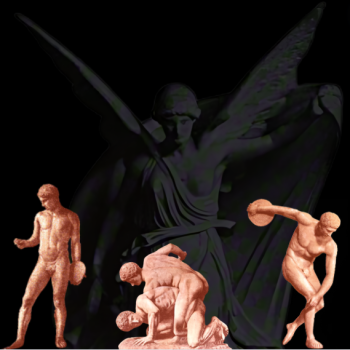SANSKRIT EXAMINATION
Charles Johnston
March 1889.
In every case, the British Indian government has followed the principle of conservation. The religious code belonging to each community has been confirmed, and family affairs, questions of marriage and succession and so forth, are regulated for each community according to its own religious laws. Thus we dispense to Hindus the precepts of Manu; Muslims have their inheritance cases decided according to the doctrines of the Qur’an; for Parsis, the Zoroastrian regulations are put in force; and perfect justice is thus secured throughout whole field of life in which religious, considerations are dominant. Here again is a tremendous achievement in statesman- ship; something the like of which the world has hardly seen in past ages. Here are a score of nations to whom perfect equality of civil rights is secured; a score of religions, each of which is protected and conserved in a spirit of perfect toleration; each is at liberty to follow its own precepts in its special field, and is at the same time compelled to extend to its rivals the same toleration which it enjoys for itself. Here is a very real liberty, such as might by no means be secured by uniform democratic government.
For uniform democratic government presupposes a certain uniformity in the citizens of the democracy, a uniformity of race, a common tongue, or at least some easy mode of inter- communication, and a fairly uniform culture and public opinion. Without this uniformity, democratic institutions will mean a perpetual oppression of minorities, and will result in anything but freedom. But the principle put in force in India does result in a very large measure of real freedom. There is, first, as we saw, the securing of universal and inviolable civil rights, with open and equal justice to all. Then there is the sympathetic and systematic study of each community, to learn its religious, moral, and social tradition, its mental atmosphere, its ideals, and usages. And, as a result, there is the wise and uniform application of these religious usages within that community, in the way which best suits its own genius and temper.
There has also been a systematic cultivation of the hundreds of languages and dialects spoken by India’s three hundred millions. Already in the eighteenth century Sanskrit type had been cast, and the great work begun of getting the priceless literature of Ancient India into print. Warren Hastings is chiefly remembered, perhaps, by Macaulay’s essay, and Sheridan’s denunciation. But it should also be recorded of him, that he was the first patron of Sanskrit literature, and helped to publish the first edition of The Bhagavad Gita. Sir William Jones, the founder of the Asiatic Society of Bengal, and thus the father of Orientalists, was an Indian judge; and his translation of Manu’s Law Code was undertaken for the purely practical end of ascertaining the Brahmanical law of inheritance. Henry Thomas Colebrooke and Charles Wilkins were also Bengal civilians; and, in later days, Max Müller’s splendid edition of The Rig Veda was paid for by the Government of India.
The popular tongues are not less carefully studied. It is an international jest of some antiquity, that Englishmen never know foreign tongues. The truth is, that no nation knows so many, or has reduced so many to writing for the first time. The British Indian Government, if my memory serves me, recognizes over a hundred different tongues and idioms; and there are at least a few officials conversant with each of them. And we have to get something more than a smattering of these tongues. We have to learn to read them, write them, and speak them fluently to the natives, using the proper forms to mark all the shadings of social rank. The members of the Covenanted Civil Service generally know three or four vernaculars well, reading, writing, and speaking them fluently and correctly. I shall never forget my first oral examination in vernacular Bengali, after I had been five or six months in India.[1] I had, as I said, studied Bengali at home for two years, and could read ordinary books, full of Sanskrit forms and phrases, fairly well: Miltonic Bengali, one might call it. But I speedily found that this was not the language of the tongues of the people, which smacks of the backwoods, not of Milton. It contained all kinds of age-old words that were current before Sanskrit first came down the Ganges valley.
I well remember, the morning of the examination. It was a sultry day in the hot season.[2] I had already acquitted myself tolerably in a conversation with the Sub-judge, a Bengali gentleman who spoke the bookish tongue that I had learned—at least he spoke it to me. Then the examiner, a Scotch Joint Magistrate named R. H. Anderson, called in a dusky peasant who had been summoned to testify in some case, and who was sitting at the door-sill, smoking a coconut water-pipe.[3] The Sub-judge brought him immediately before me and said to me abruptly: “Talk to him about his family!”[4] It would be hard to say which of us was more taken back, that skinny, brown peasant or myself. I managed, with much hesitation and difficulty, to inquire after the number, age, and well-being of his daughters. He looked as if he expected me to make him a proposal, and was evidently vastly relieved when he was dismissed, and I was told to study six months longer.[5]
In discussing the character of the Bengali language, I am met at the outset by a difficulty of definition. One grammarian wishes to exclude from Bengali all words borrowed directly from the Sanskrit; another would ignore all the colloquial or so-called “low” words; a third would set aside all loan-words from Persian and Arabic. At this rate very little of the Bengali language would be left to discuss. I believe this confusion arises from the fact that there are, in Lower Bengal, three distinct forms of the Bengali language, which I found side by side in the District of Murshidabad.
The first of these the literary dialect of Sanskrit-Bengali, is the language of the Brahmans, and the classes directly under Brahmanical influence. The second form of the language is the Mussulmani-Bengali, the literary dialect of the learned Muhammadans, and also the language introduced by the Muhammadan doctors in the legal forms and technical phrases of the law courts. These two literary dialects—the Sanskrit-Bengali and the Mussulmani-Bengali—are artificial products of quite recent origin. They stand to each other, it should be noted, in exactly the same relation as literary Hindi and Urdu, and have their origin in the same causes.
Apart from and beneath them lies the true Bengali language, the speech of the illiterate millions, the so called vernacular or “Low Bengali,” which is, for philological purposes, far more interesting and valuable than the half-Sanskrit or half-Persian jargon of the literate few. This “Low Bengali” is the language of the illiterate masses—that is, it is a language with no written documents, if we except the speeches of the inferior characters in Bengali dramas, the analogue of the Prâkrit in the Sanskrit Nâtakas. Being without proper written documents, any exact analysis of it becomes much more difficult; and, for the same reason, it is subject to great local variation.
My own observations of Low-Bengali apply primarily to the district of Murshidabad; but I am of opinion that they will be found generally true for the whole of Lower Bengal. Of the vocabulary of Low-Bengali, as talked in Murshidabad, I have formed the following conclusions: First, that the number of pure Sanskrit words is greatly less; and that the few Sanskrit words remaining are cast in a new phonetic mold, or undergo the process of weakening and slurring called “Prakritizing.” After this large Prâkrit element come what, for want of a better name, I must call aboriginal (desha-ja) words, such as pagri (turban) and donga.[6]
← Table Of Contents →
SOURCES:
[1] Johnston’s language examination was likely on his mind when he wrote his two-part essay for The Theosophist titled “Sanskrit Study in the West.” [Johnston, Charles. “Sanskrit Study in the West.” The Theosophist. Vol. X., No. 114. (March 1889): 337-344; Johnston, Charles. “Sanskrit Study in the West.” The Theosophist. Vol. X., No. 116. (May 1889): 492-496.]
[2] This would place the date of the examination sometime in March 1889. In “A Perspective On India,” Johnston writes: “Then after the cold season the flaming heat began again, presently swelling the immense channels of the Ganges with melted Himalayan snows. With March the hot season began, fanned to a blaze through April and May.” [Johnston, Charles. “A Perspective On India.” The Atlantic Monthly. Vol. CXXXVIII, No. 6. (December 1926): 848-856.]
[3] R. H. Anderson was the joint Magistrate, Deputy Collector, and acting judge of Murshidabad at this time. [“The Bengal Government.” Homeward Mail From India, China And The East. (London, England) May 22, 1888; “The Bengal Gazette.” Civil & Military Gazette. (Lahore, Pakistan) June 1, 1889; “The ‘Calcutta Gazette.’” The Englishman’s Overland Mail. (Calcutta, India) June 1, 1889.]
[4] In the article, “The Two Mexicos,” Johnston writes: “I well remember, on a sultry day of the hot season, being confronted with a somewhat perturbed peasant of one of the villages of Murshidabad, and being invited by the native judge who was conducting the examination, to ‘talk to him about his family.’ It happened that at that early date I knew only the book words for son and daughter, so the conversation did not flow. But the point was brought home.” [Johnston, Charles. “The Two Mexicos.” The Atlantic Monthly. Vol. CXXVI, No. 5. (November 1920.): 703-709.]
[5] Johnston, “Helping to Govern India.” American Political Science Association, 1906, (1906): 169-179.
[6] Johnston, Charles. “Bengali Philology And Ethnography.” The Imperial and Asiatic Quarterly Review And Oriental And Colonial Record. Vol. IV, No. 7. (July 1892): 110-123.


